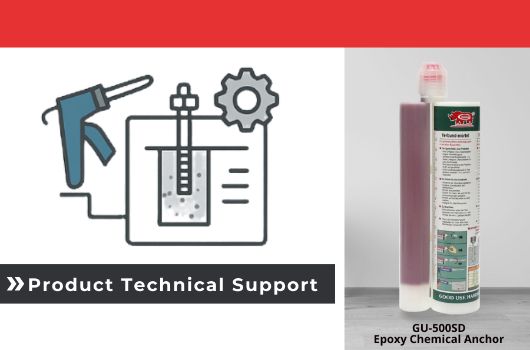
Products Information
We have compiled a list of frequently asked questions to help you quickly understand the features, usage, and services related to Good Use's chemical anchor products. If you have any additional technical or order-related inquiries, please feel free to contact us. Our professional team is ready to provide you with prompt and comprehensive support.
Yes,Good Use Hardware Co., Ltd. is the first chemical anchor manufacturer established in Taiwan. We are also the only legally certified producer in the country, fully compliant with environmental regulations...
Read moreYes! As a professional chemical anchor manufacturer, Good Use Hardware Co., Ltd. offers full customization services backed by complete in-house production and R&D capabilities.
Read moreI see several types of chemical anchors on your product list. What are the differences between them?
Good Use offers a comprehensive range of chemical anchor adhesives formulated with different resin technologies to meet diverse project demands, installation conditions, and performance requirements. Below...
Read moreStyrene is a widely used organic compound that functions as a reactive solvent in thermosetting resins such as unsaturated polyester and vinylester. It plays a key role in enhancing resin flowability and accelerating...
Read moreGood Use is one of the few chemical anchor manufacturers with complete in-house capabilities for plastic injection molding and proprietary mold development. All essential components, including cartridge...
Read moreGel time and curing time are two critical parameters that define how long a chemical anchor remains workable and when it reaches full load-bearing capacity. Understanding these timeframes ensures safe,...
Read moreGood Use Hardware Co., Ltd. follows a strict ISO 9001-certified quality management system. From raw material sourcing to resin production and final inspection, every step is carefully monitored to guarantee...
Read moreUnopened Good Use chemical anchors can typically be stored for 12 to 18 months from the manufacturing date, depending on the product series. Please refer to the product label or Technical Data Sheet (TDS)...
Read moreYes, partially used Good Use chemical anchor cartridges can be reused if they are properly stored and handled after initial use. Careful cleaning and sealing are essential to prevent resin curing inside...
Read moreA correct installation process is essential to ensure the bonding strength and overall safety of a chemical anchoring system. Unlike general adhesives, chemical anchors require precise application to achieve...
Read moreYes, chemical anchors can be installed in cold weather, but extra care is required to ensure proper performance. Low temperatures may slow down the curing process, increase gel time, or reduce bonding...
Read moreWhen opening a new cartridge of chemical anchor, it is critical to discard the first 10~20cm (approximately 4~8 inches) of extruded material. This initial portion may not be properly mixed and should never...
Read more